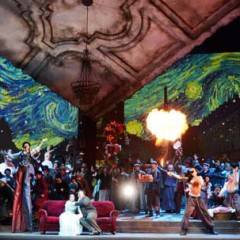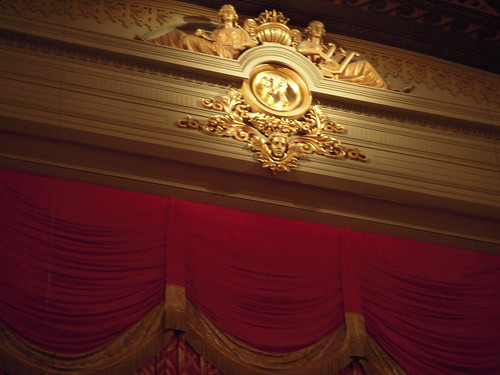
Academy of Music, (opened 1857) in the rafters above the stage where the gilt statues live, and the red curtains whisper.
The Academy of Music, that lusty old palace of red velvet and heroic gilded statuary is a great place to see opera. Fidelio, the only opera Beethoven (1770-1827) ever wrote, would seem to perfectly match the Academy. Arias and duets about love and freedom that are achingly lovely soar to the rafters and transport you to …well, usually to scenes of 19th Century interiors, bucolic fields and evil villains.
Cate and I visited the Academy to see the Opera Company of Philadelphia’s Fidelio last weekend. It’s a special, arty production, with sets and costumes by international ceramic artist Jun Kaneko, and, knowing his iconic reductivist heads (on view in New York outside on Park Avenue until Oct. 31–with a show of Kaneko’s works locally at Locks Gallery til Nov. 8), I was envisioning big heads everywhere and costumes like monks’ garb. I wondered how that would work but since Kaneko’s work is monumental and heroic at its core it makes sense to pair him with Beethoven in spite of Ludwig’s curlicues and Kaneko’s spare aesthetic.

Heroic sixpack on the statue holding up the building…
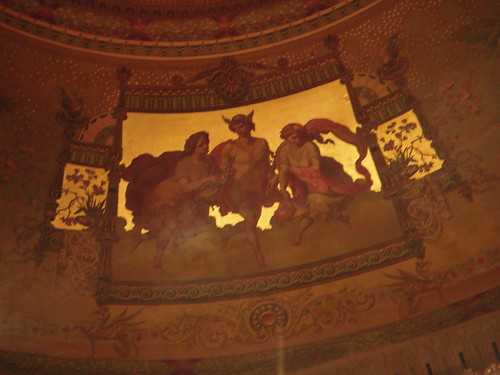
Gilt background shines like it’s on fire.
Kaneko’s design for Fidelio — the last performance at OCP is Oct. 24 — is a complete visual departure from the 19th Century. But there are no big Kaneko heads (well, there is one actually that is a flat head that hangs upside down on the background at one point) so that was an unexpected turn. The sets and costumes, though, are mostly reductivist and in keeping with the artist’s aesthetic.
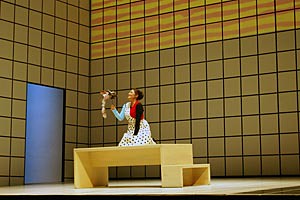
Marzelline, the jailer’s daughter who is in love with Fidelio, the disguised Leonore who is the wife of the imprisoned Florestan.
It’s an ostensibly simple set with a grid motif in back, on the floor and in one scene between the audience and the players. Furniture? There’s one lone stick of a bench. It’s a beautiful bench and in the first act, the coquette-ish Marzelline, daughter of the jailer, Rocco, makes terrific use of it. At one point the soprano even lies down flat on her back on the bench and sings — surely a heroic feat for any opera singer.
Oddly enough — odd because it doesn’t seem to advance the plot or comment on it or do anything but intrude in some places where it probably shouldn’t — a computer animation figures prominently. It’s there on the scrim during the overtures (where it’s far too competitive with the music) and it’s there in the background projecting a stream of imagery, mostly abstract, that’s usually quiet and non-intrusive but not really necessary to any part of the story or even to the set.
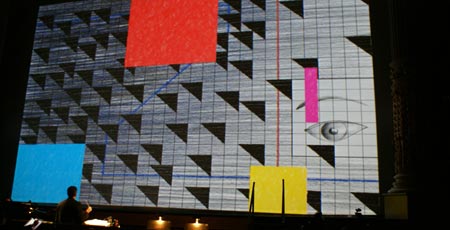
Scrim animation which takes over the music during the overture.
When it’s in the background, the animation is not competitive with the music but during the overtures when it’s on the scrim, it is so competitive that I closed my eyes at one point, the only way I could get the emotions of the music to take hold. I was happy when they raised the screen and got on with the show.

The overwhelmingness of the gridded scenery goes far to make the actors look small– like puppets or tiny dolls. In a way it’s not a bad reference for a story that is as broad as a children’s tale. Synopsis: Florestan is a political prisoner put in jail by Don Pizarro, the Governor. Leonore, Florestan’s wife, disguises herself as a man, Fidelio, and goes to the prison to try to spring her husband. Marzelline, the jailer’s daughter falls in love with the disguised Fidelio. Pizarro tries to kill Florestan but it thwarted by Fidelio and is at last caught and hauled off. Florestan (and all the prisoners) are finally liberated to great jubilation and the singing of a mini Ode to Joy-like song.

Fidelio-5317.jpg: Soprano Christine Goerke makes her role debut as the brave Leonore, who disguises herself as the man Fidelio in order to save her husband from imprisonment in Beethoven’s only opera, through October 24th with the Opera Company of Philadelphia.
Photo: Takashi Hatakeyama
The singing is so glorious that the first act’s 90 minutes goes by before you know it. Unfortunately the second act, in which all the major action takes place is pretty weak — it’s in the source material, though, apparently Beethoven had trouble with this opera and…it shows. The movement lurches from one relatively static tableau to the next. And I shouldn’t complain but, at the very end, the addition of townspeople on stage is jarring for simply this: They’re wearing 2008 garb (when we saw the production one young boy was wearing a red shirt and Phillies hat). And the hodge podge of people and costumes kept my thoughts wandering to who the “townspeople” were (friends and family of the singers?) and why they were dressed the way they were.
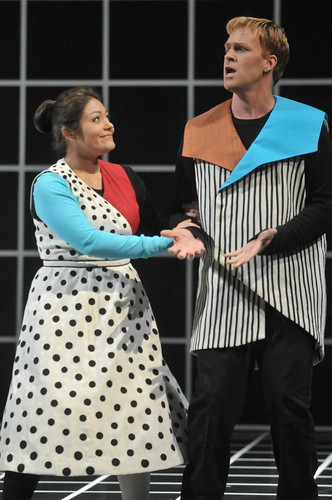
Soprano Ailyn Perez is Marzelline and tenor Brian Anderson is Jaquino in the Opera Company of Philadelphia’s new production of FIDELIO, designed by artist Jun Kaneko and running through October 24th. Photo: Kelly & Massa Photography
One other small note about the costumes. Don Pizarro is accompanied by what seem to be Star Wars storm troopers in his comings and goings on stage. The reference is unnecessary to prove the villain’s evil. Greer Grimsley, who plays Pizarro, commands the stage with his swagger, deep melodious voice and mane of hair. Like the other great cast members in a wonderful ensemble, he’s completely believable as the bad guy and doesn’t need the pith-helmeted crew. Christine Goerke‘s Leonore/Fidelio has a powerful and glorious soprano and is solid in the role; Anthony Dean Griffey, Florestan, has a hard lot in life having to sing while he’s dying on the floor in the prison. He’s good. Ailyn Perez as Marzelline is marvelous. And the rest are great too.

A scene from the Opera Company of Philadelphia’s new production of FIDELIO from Director Robert Driver and Designer Jun Kaneko. Beethoven’s only opera runs through October 24th.
Photo: Kelly & Massa Photography
The biggest emotional charge in Kaneko’s staging is the Second Act opening scene with a dramatic tableau of prisoners in the prison. It’s the coup de theatre that caused a spontaneous outbreak of applause. Now that is a staging Beethoven couldn’t have envisioned — and yet it’s one moment that meshes perfectly with the material.
Kaneko was a reluctant designer, according to the OCPs Director Robert B. Driver who explained the story to the Inquirer’s David Patrick Stearns. This is Kaneko’s second opera design–the Omaha-based artist previously did Madame Butterfly for Opera Omaha).
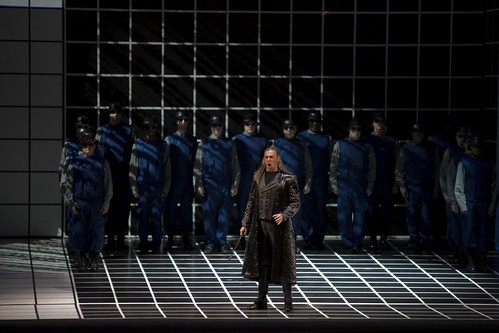
Bass-baritone Greer Grimsley is Don Pizarro in the Opera Company’s dramatic new production of FIDELIO, from Robert Driver and Jun Kaneko and running through October 24th. Photo: Takashi Hatakeyama
The OCP’s production of Fidelio is indeed a wonderful piece of theatre. My complaints about the scrim and animation are small matters when up against such pluses as the singers, the orchestra and the wonderful music. Basically the grid is good. I would have liked to see some of Kaneko’s big sculptural heads on the stage but his vision of the old story as something new works quite well. And big props to the Opera Company for taking a chance and producing what is ultimately a very successful multi-disciplinary piece. It’s for the ages.



